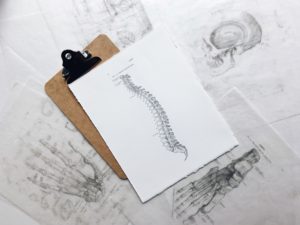
Osteoporosis runs in my family. It’s a scary but real fact. My mother’s bone density has been an issue for the past few years. Her most recent doctor has helped her by leaps and bounds, but the more I learn about health and fitness, the more it seems like a detriment to her health that she was told she is not allowed to bear weight more than 20 pounds. Everything I know tells me strength training not only helps build muscle but also strengthens your bones, not to mention increases confidence. It fortifies the muscles around those weak bones and especially strengthens your overall core, which in effect improves balance and stability, therefore improving ones day-to-day safety from potential weaknesses from decreasing bone density. BUT I’m not a medical doctor, so I hit the books, more like the internet, to find some true scientific research on my theories.
I didn’t have to dig very far to find TONS of scientific research that proves weight bearing exercises and straight up weightlifting are good for building bone and preventing bone loss. In a study conducted just one year ago on high risk individuals, the study found that “both high-impact exercise papers reviewed provide evidence that progressive training, specifically HiPRT [high-intensity progressive resistance training] and impact loading, are safe and effective for high-risk patients, especially postmenopausal women, with low bone mass. This subsequently helps to prevent OP [osteoporosis] by increasing BMD [bone mineral density] in weight-bearing areas of the body. ” Checkout this study for the details on what exercises the patients performed. These workouts not only helped their bones (by measurement) but their overall health, like increased height! Older people seem to shrink, right? It’s amazing that it can be reversed — use it or lose it!
As my mom did, many disclaimers suggest that patients with bone density issues should check specific workouts with their doctors first. As with ANY medical conditions, this is a must. BUT it is also okay to ask follow-up questions and do your own research. With these disclaimers come so much research recommending one-repetition maximum training. That means going heavy. This study published in The Journal of Strength and Conditioning Research focused on testing and monitoring lower extremities maximal strength training, aka heavy squats. ALL lumbar spine, femoral neck and total hip measurements increased in each individual in the training group. They tested bone mineral content, bone mineral density, Vitamin D levels, bone markers in serum and total area. Wow!
The International Osteoporosis Foundation also recommends 1RP workouts for postmenopausal women. Gradually increase your weight load, but the goal is to get to 80% of a one-rep max, starting with lower extremity focuses. This means deadlifting, squatting, etc. Goblet squats combine so much to increase core strength and everything else connected! These IOF workout suggestions are actually more intense than I’d expect, which is awesome. It means that you shouldn’t live your life scared that your are going to break a hip by taking step. It’s okay to push yourself! Start out carefully, and if you have the right experts by your side ensuring proper form, working out and lifting weights can only add benefit to your life.
Dr. Charlie Seltzer, MD, also suggests goblet squats, lunges and step-ups for postmenopausal women at risk for bone loss.
With all of this positive info, it was also important for me to figure out if what my mom was being told about spinal compression was correct. Specifically, she was told not to lift more than 20 pounds in any capacity, like carries, etc. Part of this already contradicts the research mentioned, but nothing I have read suggests that farmers carries are detrimental for one’s spine. Ultimately, with proper form, weighted carries improve posture. More upright posture puts less pressure on bones, muscles and organs in the long run.
The ONLY strict NO I have read about is spinal flexion, which makes perfect sense. Those who are high risk are not suggested to bend their spines forward with a rounded back. That puts pressure on the vertebrae. Conversely, back bends are widely suggested to strengthen the spine.
When issues hit home, loved ones go into protective overdrive. So take all this info, do your own research, talk to your doctors, see a personal trainer, see a chiropractor, and ALWAYS LISTEN TO YOUR BODY.
